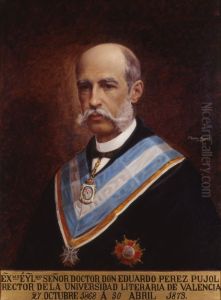Julio Cebrian Mezquita Paintings
Julio Cebrian Mezquita was a Spanish painter born on October 13, 1883, in Zaragoza, Spain. He was known for his work in a variety of mediums, including oil painting, drawing, and engraving. Cebrian Mezquita was part of the Aragonese art scene and contributed significantly to the cultural landscape of Spain during the late 19th and early 20th centuries.
Cebrian Mezquita received his initial education at the School of Arts and Crafts in Zaragoza, where he began to develop his skills in drawing and painting. He later moved to Madrid to further his studies at the Royal Academy of Fine Arts of San Fernando, which has historically been a prestigious institution for the arts in Spain. There, he was exposed to the work of many great Spanish artists and also had the opportunity to study historical Spanish art, which influenced his style and choice of subjects.
Throughout his career, Cebrian Mezquita exhibited his work in various venues, gaining recognition and accolades for his artistic talent. His style was often characterized by a focus on traditional Spanish themes, such as landscapes, portraits, and historical scenes. He was skilled in capturing the light and atmosphere of his native Aragon, and his works often reflect a deep appreciation for the beauty and character of the region.
Cebrian Mezquita's contribution to Spanish art was not limited to his paintings. He was also a respected teacher and mentor to younger artists. Throughout his life, he remained an active participant in the artistic community, engaging in cultural debates and advocating for the arts.
Julio Cebrian Mezquita passed away on June 6, 1962, leaving behind a legacy of work that continues to be appreciated for its representation of Spanish culture and its technical proficiency. His works are held in various private and public collections, including museums in Spain, where they serve as a testament to his skill and dedication to the arts.
